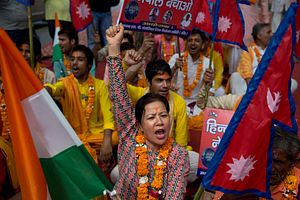In the Indian general election slated for April and May, Prime Minister Narendra Modi’s Bharatiya Janata Party (BJP) is expected to struggle to maintain its hold on power. In a possible bellwether, the BJP lost several important state-level elections in December 2018. The BJP faces challenges from its main rival, the Indian National Congress, as well as other regional parties on issues related to governance, corruption, unemployment, and caste- and language-based identity issues.
In addition, religion will play a major role in the election.
Since its founding in 1980, the BJP’s calling card has been Hindu nationalism (despite certain BJP leaders, such as Atal Vajpayee, prime minister from 1998-2004, advocating a “softer” form of it). India is a secular state, but in recent years the BJP has focused on divisive religious issues like the protection of the cow – an animal that is sacred to Hindus, who make up about 80 percent of the Indian population, but not for Muslims, who are India’s largest minority.
One of the BJP’s most radical ideologues, the Hindu monk-turned-politician Yogi Adityanath, has made cow protection a centerpiece of his work since becoming the head of government in Uttar Pradesh, India’s most populous state, in 2017. Adityanath’s government has cracked down on illegal slaughterhouses – many of them owned by Muslims – and local authorities have sometimes turned a blind eye as vigilante mobs lynched traders suspected of selling cattle for beef.
But the crackdown on cow slaughter in Uttar Pradesh has had unintended consequences. As the Indian environmental magazine Down to Earth reported in January, the new policy has disrupted an age-old symbiotic relationship between Hindu farmers, who need to dispose of old, unproductive cattle, and Muslim slaughterhouse owners and leather workers, who bought them. Many Hindu farmers now release cattle they can no longer afford to feed into neighboring villages, where they wreak havoc by eating crops. In some places, the feral cow problem has become so serious that farmers are rounding them up, driving them into forests in Nepal (which borders UP), and letting them go.
One BJP activist told Down to Earth: “It doesn’t create tension among villages and the animals are left safe as Nepal is a Hindu nation.”
The activist’s reasoning can be critiqued on several levels; for example, the cattle are liable to be eaten by the tigers and leopards that roam Nepal’s forests. But the statement also illustrates a common Indian misconception about Nepal, a small neighbor whose internal politics the average Indian pays little attention to.
Historically, Indian Hindu nationalists held up Nepal as an example of how India could adopt a strong Hindu identity. Ruled by Hindu kings from the 18th century until 2006, Nepal was never colonized. But in 2007, Nepal became a secular republic. While some Hindu laws remain in place, today the country’s main Hindu nationalist party controls only a single seat in parliament. Unlike in India, where Hindu nationalist politics has been on the rise since the late 1980s (when the BJP first won a substantial number of seats in parliament), “Hindu nationalism” as a movement cannot be said to be strong in Nepal. A closer examination of the reasons why exposes important fault-lines in Nepali politics today, and provides perspective on the Hindu nationalist movement in India.

































